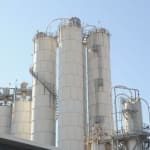 SABIC positioned to meet rising automotive OEM demand for PP in North America with official opening of U.S.-based compounding operation.
SABIC positioned to meet rising automotive OEM demand for PP in North America with official opening of U.S.-based compounding operation.SABIC’s Innovative Plastics business today celebrated a major milestone with the official opening of its specialty polypropylene (PP) compounding operation at its Bay St. Louis, Mississippi manufacturing site. The new compounding operation will supply SABIC PP compounds and SABIC Stamax long glass fiber-filled PP (LGFPP) composites for a wide range of automotive applications.
SABIC’s new PP operation answers fast-accelerating demand from automotive OEMs and tiers for local supply of globally-consistent PP materials in North America, supporting production of both regional and global vehicle platforms. This is the second time in 17 months that SABIC has opened a PP compounding facility, having celebrated the start-up of its Genk, Belgium plant in June 2010. SABIC’s PP investments underscore the company’s commitment to provide high-performance materials that can help automotive OEMs pursue weight reduction opportunities and achieve energy-efficient improvements in vehicles.
“In today’s fast-paced automotive industry, we continually strive to help our customers respond to new challenges and demands,” said Gregory A. Adams, vice president, Innovative Plastics, Automotive. “One of those challenges is the movement of many OEMs towards global vehicle platforms, with the resulting demand for high-quality, consistent materials that meet specifications across multiple regions. With this investment in Bay St. Louis, we have significantly boosted our capability to meet that demand and deliver even more responsiveness to our global customers, their engineering teams, and suppliers.”

Innovative Plastics installed the new PP capacity in Bay St. Louis by drawing upon the design and technology of the company’s Genk plant, the largest greenfield PP compounding plant ever built in Europe. This world-scale facility supplies PP compounds to Europe and SABIC Stamax LGFPP composites to Europe and Asia Pacific. Genk also houses a Compounding Innovation Center with three pilot lines designed to speed the development cycle for new products and processes.
“With the investment in Bay St. Louis, we have taken the expertise that we have accumulated in Europe and the rest of the world and added it to North America,” said Leon Jacobs, polypropylene global leader Innovative Plastics, Automotive. “As a result, we have strengthened our ability to supply OEMs in this region with the uniform polypropylene materials that meet global materials specifications. Moving forward, these same customers will benefit from our ability to develop global polypropylene products and deliver local support in validating those materials, thanks to our globally integrated automotive organization and globally networked application development centers.”
PP materials in the automotive sector have shown steady growth over several decades – at about three to five percent per year, on average – and have replaced metals and other polymers in various parts and components.
PP’s versatility and ease of processing contribute to growing demand. Today, PP compounds are the preferred solution in many automotive applications, including bumper fascias, instrument panels (IPs), door panels, interior trim and other parts. OEMs in Europe first used SABIC Stamax LGFPP composites in the early 2000s, primarily for large molded parts such as front-end modules, door modules, IP carriers, tailgates and seat structures. Demand has continued to grow, with OEMs worldwide choosing SABIC Stamax LGFPP composites for their outstanding combination of strength, dimensional stability and high flow for thin-wall structural parts.
SABIC Stamax LGFPP composites offer several advantages over other materials in automotive applications: weight savings and corrosion-resistance compared with steel; greater design freedom as it can be injection-molded, compared to compression-molded materials; lower costs because it needs fewer finishing operations; high heat-deflection temperatures; low thermal expansion; high-stiffness, impact resistance and tensile strength; and low creep.
“Automakers have enjoyed tremendous success with our polypropylene materials for over three decades,” said Jacobs. “We are excited to help customers in the NAFTA countries tap into this proven portfolio of polypropylene solutions for the development of cars in various world markets; and the timing could not be better with OEMs exploring new opportunities for these materials in automotive designs.”
“New doors are opening for polypropylene and the broader category of thermoplastic materials,” Jacobs continued. “In components for hybrid and electric vehicles; in the under-hood area where heat is not a critical factor; and in semi-structural applications where polypropylene can allow for the creation of highly integrated parts to further reduce mass and cost.”
SABIC’s portfolio of automotive plastics is one of the largest and most diverse in the industry. In addition to PP materials, it includes a comprehensive range of engineering thermoplastic resins. Combined, these polymers represent 60 percent of the plastics used today in vehicle construction and present opportunities for innovative application development that can further drive out weight and cost for next-generation vehicles.



